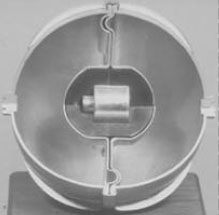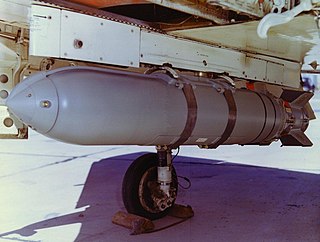
The M34 cluster bomb was the first mass-produced United States Army weapon meant to deliver the chemical agent sarin (GB). A large stockpile of M34s was destroyed between 1973 and 1976.

The M34 cluster bomb was the first mass-produced United States Army weapon meant to deliver the chemical agent sarin (GB). A large stockpile of M34s was destroyed between 1973 and 1976.
As the United States Army Chemical Corps focused its efforts on the weaponization of sarin nerve agent (GB) during the 1950s the M34 cluster bomb was the first such weapon mass-produced by the Army. [1] The weapon was the United States' first major nerve agent weapon after World War II. [1]
The M34 had a diameter of 14 inches (36 cm) and a length of 86 inches (218 cm). [2] This particular cluster bomb was designed to carry a total weight of 108 pounds (49 kg) of sarin nerve agent, the weapon's total weight was 525 pounds (238 kg). [2] The M34 cluster bomb held 76 M125 bomblet sub-munitions, each of the sub-munitions held 2.6 pounds (1.2 kg) of GB. [2] The weapons also contained a parachute, an opening delay, fuze, and a burster which held 8.8 ounces (250 g) of tetryl. [2]
When Operation Cut Holes and Sink 'Em (CHASE) was cancelled the Army had to scrap a plan to dump more than 20,000 M34 cluster bombs at sea. [2] In 1972 there were still more than 21,000 M34 cluster munitions stored at the Rocky Mountain Arsenal, near Denver, Colorado. [2] Between 1973 and 1976 the Army began destroying these munitions under the auspices of Project Eagle. [3] To dispose of the munitions the Army drained the Sarin from the bomblets, mixed it with a caustic inside a reactor chamber, and spray-dried the brine. [3] Project Eagle resulted in the demilitarization and destruction of about 450,000 U.S. gallons (1,700,000 L; 370,000 imp gal) of Sarin and 6.25 million pounds (2,830 t) of the spray-dried salt. [3] The salt was stored in 18,000 steel and fiberboard drums and placed in a toxic storage site at Rocky Mountain Arsenal. [3]

Chemical warfare (CW) involves using the toxic properties of chemical substances as weapons. This type of warfare is distinct from nuclear warfare, biological warfare and radiological warfare, which together make up CBRN, the military acronym for chemical, biological, radiological, and nuclear, all of which are considered "weapons of mass destruction" (WMDs), a term that contrasts with conventional weapons.

Sarin is an extremely toxic synthetic organophosphorus compound. A colourless, odourless liquid, it is used as a chemical weapon due to its extreme potency as a nerve agent. Exposure is lethal even at very low concentrations, where death can occur within one to ten minutes after direct inhalation of a lethal dose, due to suffocation from respiratory paralysis, unless antidotes are quickly administered. People who absorb a non-lethal dose and do not receive immediate medical treatment may suffer permanent neurological damage.

The Rocky Mountain Arsenal was a United States chemical weapons manufacturing center located in the Denver Metropolitan Area in Commerce City, Colorado. The site was completed December 1942, operated by the United States Army throughout the later 20th century and was controversial among local residents until its closure in 1992.
Blue Grass Army Depot (BGAD) is a U.S. Army Joint Munitions Command storage facility for conventional munitions and chemical weapons. The facility is located in east central Kentucky, southeast of the cities of Lexington and Richmond, Kentucky. The 14,494-acre (58.66 km2) site, composed mainly of open fields and wooded areas, is used for munitions storage, repair of general supplies, and the disposal of munitions. The installation is used for the storage of conventional explosive munitions as well as assembled chemical weapons. The depot primarily is involved in industrial and related activities associated with the storage and maintenance of conventional and chemical munitions.
Operation Red Hat was a United States Department of Defense movement of chemical warfare munitions from Okinawa, Japan to Johnston Atoll in the North Pacific Ocean, which occurred in 1971.

Johnston Atoll Chemical Agent Disposal System (JACADS) was the U.S. Army's first chemical munitions disposal facility. It was located on Johnston Island, at Johnston Atoll and completed its mission and ceased operation in 2000.

The M55 rocket was a chemical weapon developed by the United States in the 1950s. The United States Army produced both Sarin and VX unitary warheads for the M55.

The M139 bomblet was an American sub-munition designed for use in warheads as a chemical cluster munition. Each spherical bomblet held 590 grams (1.3 lb) of sarin nerve agent.

The M33 cluster bomb, also known as the (M33) Brucella cluster bomb, was a U.S. biological cluster bomb developed in the early 1950s and deployed in 1952. It was the first standardized biological weapon in the U.S. arsenal.

The M43 BZ cluster bomb, or simply M43 cluster bomb, was a U.S. chemical cluster bomb intended to deliver the incapacitating agent known as BZ. The weapon was produced in the early 1960s and all stocks of U.S. BZ were destroyed by 1989.
The M138 bomblet was a sub-munition of the U.S. chemical weapon, the M43 BZ cluster bomb. The bomblet contained BZ, an incapacitating agent and was developed with the M43 in 1962. The M138s, along with all other U.S. BZ weapons were destroyed during the 1980s.

The M44 generator cluster was an American chemical cluster bomb designed to deliver the incapacitating agent BZ. It was first mass-produced in 1962 and all stocks of the weapons were destroyed by 1989.

The Weteye bomb was a U.S. chemical weapon designed for the U.S. Navy and meant to deliver the nerve agent sarin. The Weteye held 160 kg (350 lb) of liquid sarin and was officially known as the Mk 116. Stockpiles of Weteyes were transferred to Utah in the 1980s amidst controversy and protest.
The M125 bomblet was a U.S. chemical sub-munition designed to deliver the nerve agent sarin. It was brought into service in 1954 with the M34 cluster bomb as part of the first U.S. air-delivered nerve agent weapon.

The MC-1 bomb was the first U.S. non-clustered air-dropped chemical munition. The 750-pound (340 kg) MC-1 was first produced in 1959 and carried the nerve agent sarin.

The M134 bomblet was a U.S. chemical sub-munition designed for use in the Honest John rocket during the 1950s. The weapon was never mass-produced and was supplanted in 1964 by an improved design, the M139.
Throughout history, chemical weapons have been used as strategic weaponry to devastate the enemy in times of war. After the mass destruction created by WWI and WWII, chemical weapons have been considered to be inhumane by most nations, and governments and organizations have undertaken to locate and destroy existing chemical weapons. However, not all nations have been willing to cooperate with disclosing or demilitarizing their inventory of chemical weapons. Since the start of the worldwide efforts to destroy all existing chemical weapons, some nations and terrorist organizations have used and threatened the use of chemical weapons to leverage their position in conflict. A notable example includes the use of such weapons by the US government that sprayed more than 20 million gallons of various herbicides over Vietnam, Cambodia and Laos from 1961 to 1971. Agent Orange, which contained the deadly chemical dioxin, was the most commonly used herbicide. Other examples of the use of chemical weapons are Iraq’s Saddam Hussein on the Kurdish village Halabja in 1988 and their employment against civilian passengers of the Tokyo subway by Aum Shinrikyo in 1995. The efforts made by the United States and other chemical weapon destruction agencies intend to prevent such use, but this is a difficult and ongoing effort. Aside from the difficulties of cooperation and locating chemical weapons, the methods to destroy the weapons and to do this safely are also a challenge.
The United States chemical weapons program began in 1917 during World War I with the creation of the U.S. Army's Gas Service Section and ended 73 years later in 1990 with the country's practical adoption of the Chemical Weapons Convention. Destruction of stockpiled chemical weapons began in 1985 and is still ongoing. The U.S. Army Medical Research Institute of Chemical Defense (USAMRICD), at Aberdeen Proving Ground, Maryland, continues to operate.